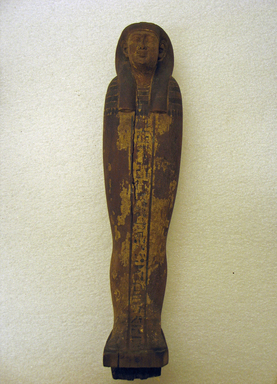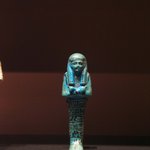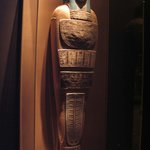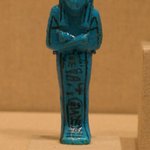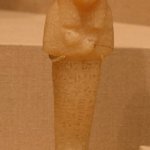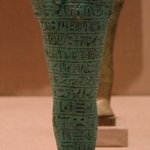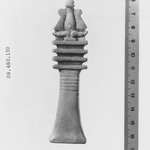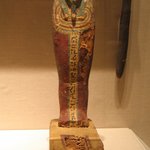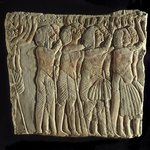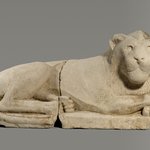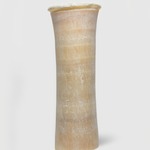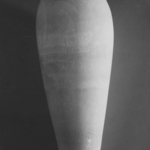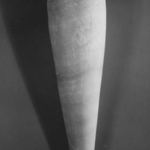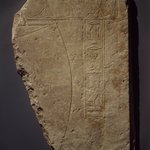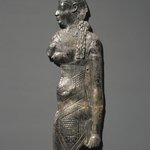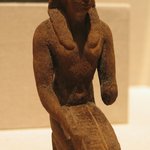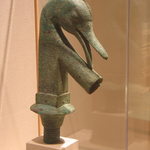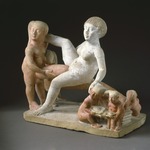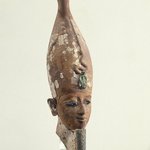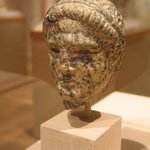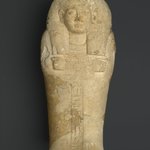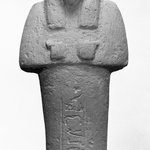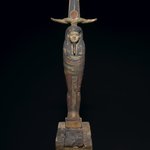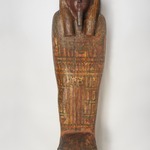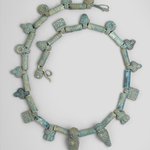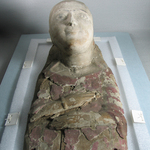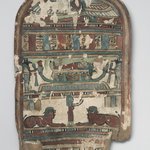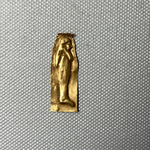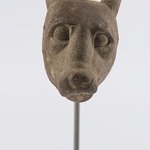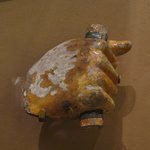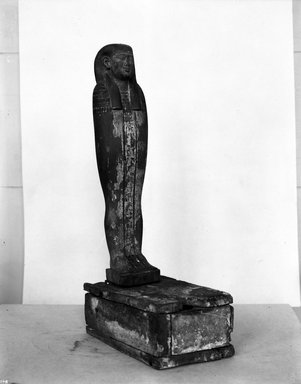

Mummiform Figure of Osiris, 305–30 B.C.E. Wood, plaster, pigment, Figure: 17 1/8 x 3 3/4 x 2 3/8 in. (43.5 x 9.5 x 6 cm). Brooklyn Museum, Charles Edwin Wilbour Fund, 37.1377E. Creative Commons-BY (Photo: Brooklyn Museum, 37.1377E_NegA_glass_bw_SL4.jpg)
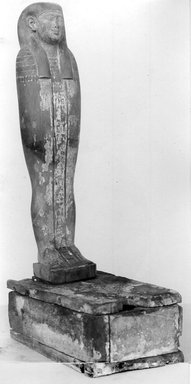
Mummiform Figure of Osiris, 305–30 B.C.E. Wood, plaster, pigment, Figure: 17 1/8 x 3 3/4 x 2 3/8 in. (43.5 x 9.5 x 6 cm). Brooklyn Museum, Charles Edwin Wilbour Fund, 37.1377E. Creative Commons-BY (Photo: Brooklyn Museum, CUR.37.1377E_bw.jpg)
Mummiform Figure of Osiris
Egyptian, Classical, Ancient Near Eastern Art
MEDIUM
Wood, plaster, pigment
DATES
305–30 B.C.E.
PERIOD
Ptolemaic Period
DIMENSIONS
Figure: 17 1/8 x 3 3/4 x 2 3/8 in. (43.5 x 9.5 x 6 cm)
Base: 2 15/16 x 5 5/16 x 9 13/16 in. (7.5 x 13.5 x 25 cm) (show scale)



COLLECTIONS
Egyptian, Classical, Ancient Near Eastern Art
ACCESSION NUMBER
37.1377E
CREDIT LINE
Charles Edwin Wilbour Fund
CATALOGUE DESCRIPTION
Mummiform figure with wig-cover, unbearded. No indication of arms. Thin plinth under feet and beneath it a cubical block for insertion in the pedestal. The figure wore a bead-collar which disappeared under the wig behind; that is, was represented as longer like those worn in life, instead of stopping on shoulders. Good, close-grained wood of pleasing light-brown color. Presumably the base once contained a papyrus or mummied animal.
Men-zed–hor the name – no parallels, whereas Zed-hor is an exceedingly common name.
Almost entirely gone but enough remains to establish that the mummy wrappings were represented as white, the face, ears, and throat were gilded. The inscription is black, the lines bordering the inscription were once dark blue and the wig cover was solidly painted in the same color except for the strips at the bottom which were white (both on shoulder-tabs and behind); the color now green was in all probability originally blue.
Corners of mouth raised. Has the typical expression of later figures. Eyebrows and eyelids delicately carved. Aside from the face, the best of the carving is on the lower part of the figure. The knees, calves, ankle-bones and heels are skillfully indicated through the mummy wrappings, while the breast is quite formless and the arms are suppressed entirely!
A box with two compartments, the smaller to contain the dowel of the statuette, the larger a chamber for a smaller, mummy (?). Put together of a number of pieces of wood. The top was made of 3 pieces of board the joints running diagonally. The bottom
was made of two pieces, joints running diagonally pegs lying horizontally hold two pieces together between them the bottom sides, the interior partition, and the pegs are driven in diagonally, a few lie horizontally connecting the boards of floor, each of one piece of board, are inclosed, and the whole is pegged together. The boards vary in their thickness from 5 mm. to 2 cm. Holes in the wood have been filled in with plaster. The wood is soft and now very dry and much split. The whole was originally plastered over, largely hiding the pegs and joints and painted. Traces remain of pink-yellow color and green borders inclosed in heavy black lines, on the front and sides. The back has lost all its paint. On the top the remaining plaster is so begrimed that the color is no longer distinguishable. This piece illustrates well the economy the Egyptians used with their wood. In the cavity were found fragments of brown stained mummy-wrappings bits of plaster from the exterior of the box, but no animal or papyrus remains.
Condition: Inscription too damaged to be legible. The headdress, pedestal (found later see separate ship), and tip of nose are missing. There is a deep crack running downward more than half way from the throat at the feet. An imperfection in the wood on top of the head was filled in with plaster. The hole to receive the dowel of the headdress is now filled with black wax or bitumen and has a wooden pin sticking in it.
MUSEUM LOCATION
This item is not on view
CAPTION
Mummiform Figure of Osiris, 305–30 B.C.E. Wood, plaster, pigment, Figure: 17 1/8 x 3 3/4 x 2 3/8 in. (43.5 x 9.5 x 6 cm). Brooklyn Museum, Charles Edwin Wilbour Fund, 37.1377E. Creative Commons-BY (Photo: Brooklyn Museum, 37.1377E_NegA_glass_bw_SL4.jpg)
IMAGE
overall, 37.1377E_NegA_glass_bw_SL4.jpg. Brooklyn Museum photograph
"CUR" at the beginning of an image file name means that the image was created by a curatorial staff member. These study images may be digital point-and-shoot photographs, when we don\'t yet have high-quality studio photography, or they may be scans of older negatives, slides, or photographic prints, providing historical documentation of the object.
RIGHTS STATEMENT
Creative Commons-BY
You may download and use Brooklyn Museum images of this three-dimensional work in accordance with a Creative Commons license. Fair use, as understood under the United States Copyright Act, may also apply.
Please include caption information from this page and credit the Brooklyn Museum. If you need a high resolution file, please fill out our online application form (charges apply).
For further information about copyright, we recommend resources at the United States Library of Congress, Cornell University, Copyright and Cultural Institutions: Guidelines for U.S. Libraries, Archives, and Museums, and Copyright Watch.
For more information about the Museum's rights project, including how rights types are assigned, please see our blog posts on copyright.
If you have any information regarding this work and rights to it, please contact copyright@brooklynmuseum.org.
RECORD COMPLETENESS
Not every record you will find here is complete. More information is available for some works than for others, and some entries have been updated more recently. Records are frequently reviewed and revised, and we welcome any additional information you might have.
